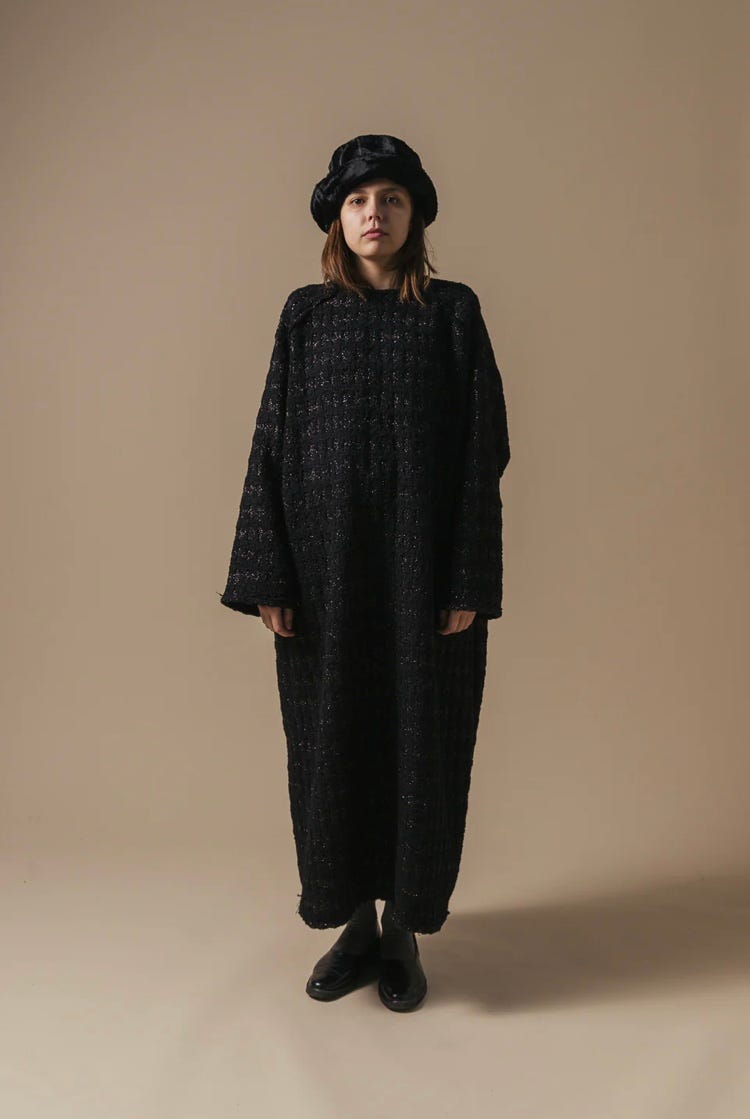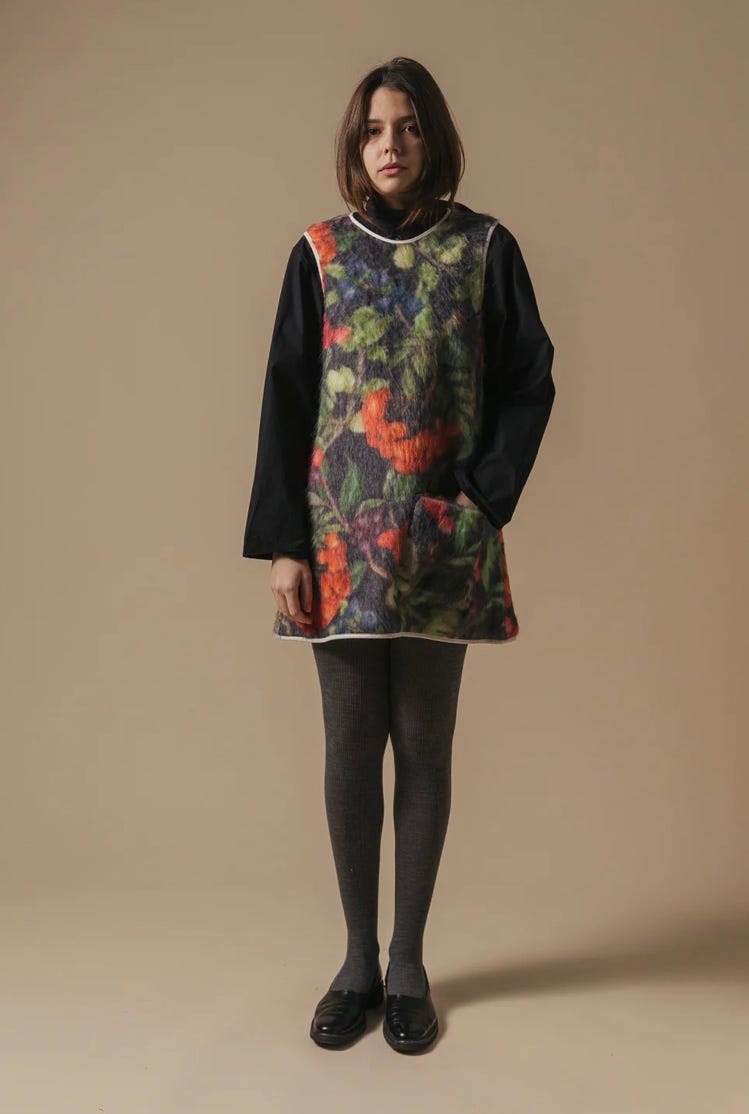PRESENT FOREVER is the new go-to source for exploring independent clothing brands, makers and stores from across the globe
You’re reading what’s the first feature on a womenswear brand on this website. When I started writing it, I seized the opportunity to draw up an essay addressing the question whether it matters when men write womenswear and vice versa. I believe I lost about 15 subscribers because of it. That’s a pity, of course. Perhaps it’s a sign of fashion’s non-political leanings. Perhaps I was being too over-conscious or too imprecise. I don’t know. Luckily, I also received kind words which encouraged me to continue on my own slippery path.
Without wanting to re-open Pandora’s box, in the short piece (‘Fashionable Self-Criticism’) I obviously forgot to mention one rather crucial consideration: all human binaries are as unreal as they’re historically contingent — everyone has masculine, feminine and genderless features irrespective of sex assigned at birth. Looking at clothing, there are garments that signified one gender construct at period x and another at period y. Think of skirts, for example, which were worn by men and women since pre-historic times but suddenly became female-only from the 18th century — in Europe and North America at any rate. Or think of high heels, which were originally geared towards the practical needs of men (e.g. helping 10th-century Persian horsemen to keep their shoes in their stirrups). Norena Shopland, in her History of Women in Men’s Clothes, gives many more examples, including historical cases of cross-dressing as an emancipatory strategy.
To acknowledge the unreality of human binaries doesn’t automatically mean to act upon them. Many brands, from slow and independent to fast and investor-owned, promote unisex or gender neutral clothing. But in reality their items often only fit one body type. And, more generally speaking, whereas designs seen as masculine are often considered to fit both men and women, designs seen as feminine are typically marketed exclusively for women. “Rather than just saying everything is going to be for everyone,” says Mike Eckhaus, it’s crucial to really “refine the design and explore new silhouettes.”
To me personally, Amsterdam-based label Eleph is the epitome of womenswear I’m into — with Cawley a close second, Bode a close third, and Toujours a close fourth. By “into” I guess I mean something along the lines of: I enjoy looking at it, I find it aesthetically pleasing, I appreciate the designs, fabrics and constructions, and I wish some of its items were available in my size, and made to fit my particular 6”2 body type, so that I could wear them in principle. Looking at Cawley — which now also does menswear — Bode — the first female designer to show at NYFW: Men’s — and Toujours—the womenswear counter-part of TS(S)—I have to admit I actually often like their womenswear even more than their menswear.
What sets these womenswear labels apart from many menswear brands out there is their fabric-first approach. Here, I’m not thinking of starting with the sourcing and choice of fabrics. That seems to be common practice now for most independent brands. I’m thinking instead of first-hand knowledge or deep know-how of the movement of fabrics — of where they need flexibility or stability — as well as of which materials require clean, precise cuts and seams and which require drape and hang. Besides, in the period between Christmas and New Year’s eve, I realized time and again that womenswear designers — whether it’s Fleur Muijsson from Eleph, Hannah Cawley from Cawley, Emily Adams Bode Aujla from Bode, or Masayo Shimendo from Toujours — tend to be much better at making festive, cheerful attire, offering that rare feeling of indulgence. It’s something Eleph, especially, is really good at: the creation of an aesthetic of quiet extravagance, low-key elegance or understated glamour, full of well-considered glitters, sparkles and twinkles. Or, as the brand itself captures the sentiment, they celebrate “happy accidents and grand experiments.”
I can think of no equivalent in menswear, where outgoingness currently seems limited to deliberate — anger- rather than joy-inspired — rips, tears and holes. That’s an issue worth exploring, I’d say: how to take festive menswear beyond gowns and tailoring?
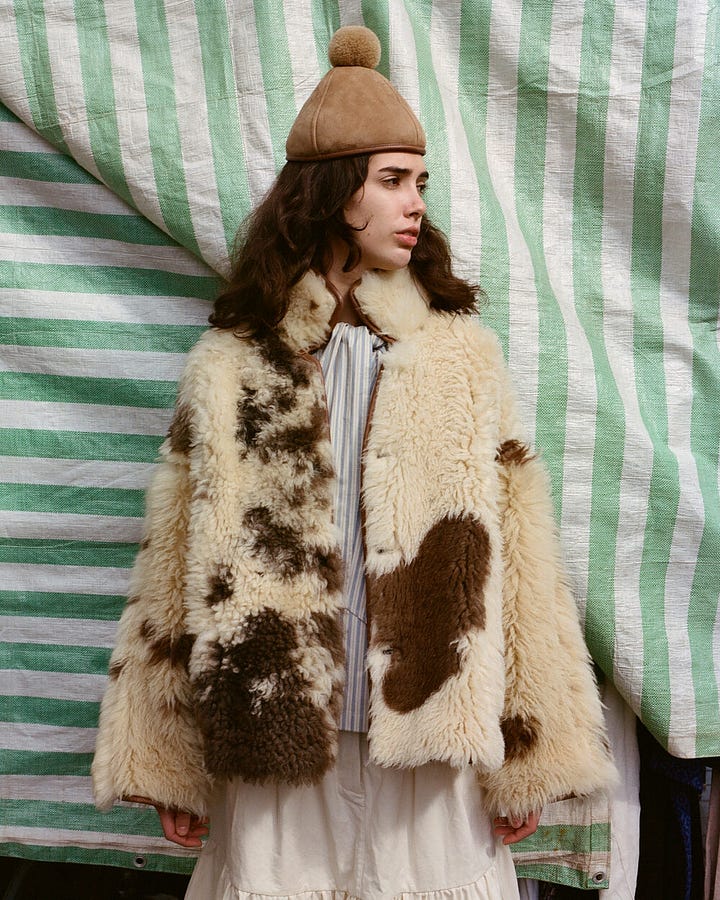



I really like how Eleph — whose AW24 sale is still in full swing — has managed to make their visuals reflect this characteristic approach. If you visit their website or socials now, you see different images of the same young woman. She looks a bit shy and very self-confident at the same time, sporting glittery pieces with a fierce look and appearing to contemplate what she’s wearing while wearing it (as if that’s entirely inherent to the garment’s form and function).
Eleph was founded in Amsterdam, the Netherlands in 2019. A relatively young brand with seven collections to date, it has a dedicated following as well as over 40 stockists around the globe, including ten in China. Over a period of a few weeks this fall and winter, I had an e-mail exchange with Eleph’s founder and designer Fleur Muijsson, who was so kind to offer an in-depth look into her personal ambitions and vision.
Lukas Mauve (LM): Do you recall where you were when you decided to start Eleph, and what inspired the decision?
Fleur Muijsson (FM): “After having been in the industry for about 15 years, I found myself at the kitchen table during Covid with a beauty of a baby boy and hundreds of ideas. I knew I had to try to do something that would renew my energy, not only from the sleepless nights but also because I had gotten tired of the industry’s wasteful thinking and market driven approach. So I guess being mom to a newborn was inspiring, the authenticity of that moment made it feel like I had to try and create something that was authentic to myself as well.”
LM: What jobs and roles did you have in the industry prior to founding Eleph?
FM: “My first ‘official’ job was for a garment manufacturer in China. They owned six factories and a yarn mill and we would do developments and productions for designer brands like Joseph, Chloé, Marc Cain as well as Massimo Dutti, Maje, Paule Ka to name a few. Looking back, these were my educational years, traveling from all the factories creating new yarns and fabrications — to do sourcing and developing — to meetings with these brands to further develop or finalize orders. I did this for about eight years and had many different roles within the company. The best part of it was that it intensified my knowledge at least tenfold. I’d say that in terms of technical knowledge, design experience and production awareness this was the best masterclass ever.”
“I then went on with my business partner to create our own agency, where we would source manufacturers, mills, materials, identifying their strengths and creating collections with them, and then showcasing to the brands I mentioned earlier. This was the period in which a really got a taste of entrepreneurship. During the first years of this business, my partner and I founded a new brand, Extreme Cashmere. That chapter closed for me about three years later. I moved on to become Head of Design with Humanoid and finally moved back into production as P&D Manager at McGregor. After that, I settled into my new life with my life partner and kid.”
LM: The name “Eleph” is derived from the French word élephante. Could you tell me what it is about the elephant that inspires/is reflected in what the brand does? Or, more specifically: how does Eleph channel the strength and goodness characteristic of this majestic animal?
FM: “In those early days in 2019, after my son was born, we often visited my aunt. She has her house decorated with elephants in every shape and form — paintings, figurines, curtains, you name it! My son and I started sharing her love for elephants of which their humble traits indeed are strength and goodness, which was something I could relate to and wanted to pursue in all aspects of my own life as well. It relates very strongly to the brand as it was founded and as it exists today.”
“We aim to choose and work with our fabrications wisely, meaning that the material selection is done based on composition and quality. The shapes are simple and easy to wear. We have long-standing connections with our suppliers who all create and make our materials with much authenticity, craftsmanship and innovation. We then use those materials as they are, creating shapes that complement them, and in keeping garments simple yet functional we avoid unnecessary embellishments, trims or metals completely.”
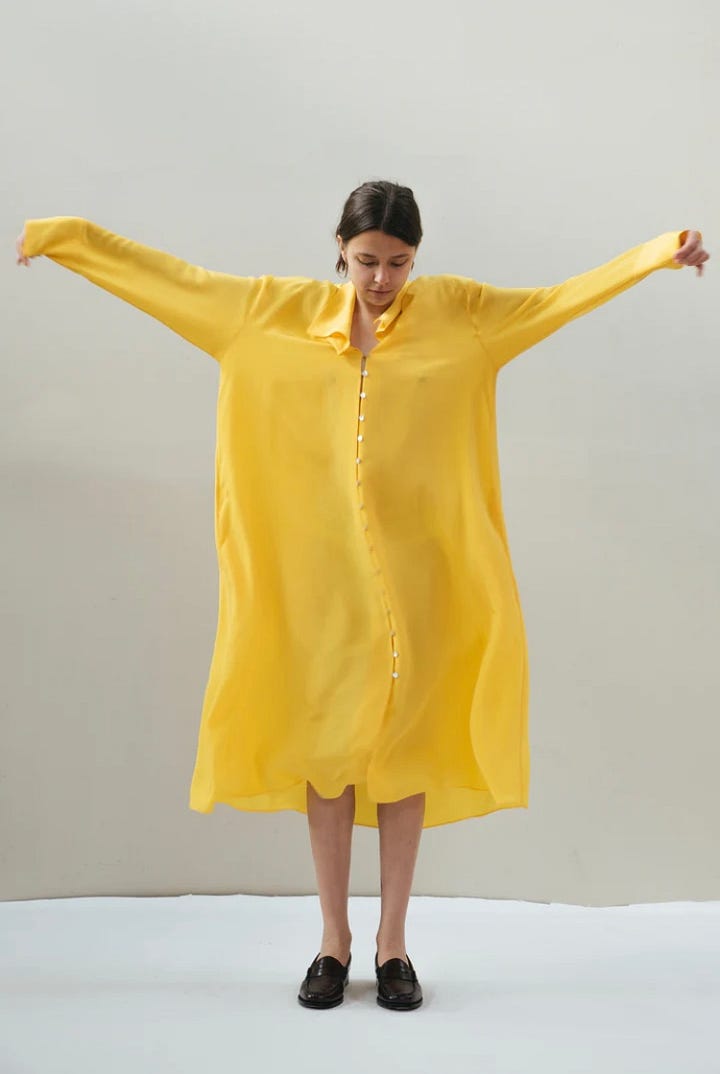

LM: Eleph has presented seven collections so far. I’d like to briefly reflect on them. Let’s start with the name of the SS22 collection, your first: ‘Pre-Upcycled’. What was the idea behind this concept? And how is it related to the other SS22 collection, ‘Imme’?
FM: “Our first collection was idealistically made from all upcycled materials. This was our initial business plan if you will. However, a few months in we found this very hard to pursue. We were still right in the middle of Covid at that time.”
“We had to buy and produce the SS22 items on our own accord, as is so often the case with upcycling: there’s no time to wait for retail orders as these fabrications cannot be “blocked.” This simply created too many uncertainties for a starting brand.”
“To have a bit of a ‘proof of concept’ we needed some sort of feedback on the brand’s direction. We decided to do another small sample collection to present at Paris and Tokyo Fashion Week. That gave us an introduction to our first customers. From that moment on we decided to incorporate upcycled fabrics alongside new, long-lasting materials while also further our growth and efficiency to be able to work with more with upcycled materials.”
LM: Do you recall what kind of feedback you received on the SS22 collections? And, looking back, how did this feedback influence or change the course of Eleph for the collections that followed?
FM: “Well, not that much feedback to be honest! But I immediately found a great Japanese agent who was keen to move further and we have had a first customer as well as some responses from stores I admired, such as La Garçonne.”
“The styles that got most traction were the pieces that had a bit more special handwriting to them in terms of shape, color and fabrication. That came as somewhat of a surprise as I’d thought the basics would be the items that would get picked up more easily. Going forward the feedback we received did help us focus more on our design handwriting, which is now becoming the ‘Eleph woman’.”

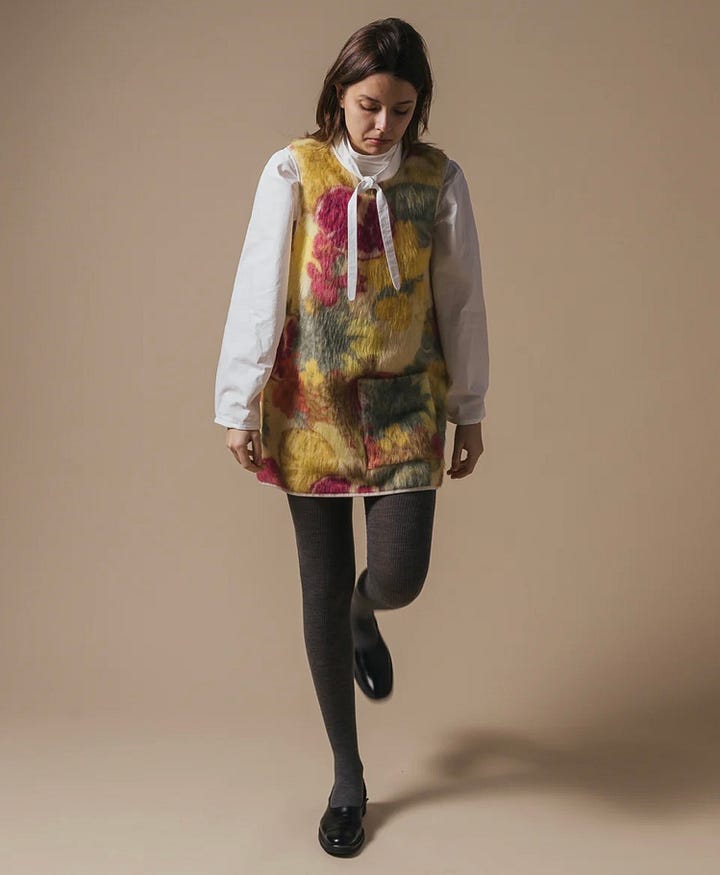
LM: I noticed you’ve returned to similar designs in different collections. What’s your main motivation for working that way?
FM: “Just because we love them. They have essentially become the evergreens of the brand, and people really seem to relate to them well. Also for us as a team it offers a nice ‘check moment’, for instance when we see a fabric and we know it would look great in one of our skirts, coats or vests we know it’s a real ‘Eleph fabric’.”
LM: I read that the choice of material/fabric is often the starting point for an Eleph item. Is that primarily because you try to work with left-overs as much as possible? Or does it capture something else about your design approach?
FM: “I don’t think this is unique. In my mind it’s very strange to work the other way around, sketching before you know the fabrication’s drape or how it needs to be worked with. If you look at and work with a fabric first you can find out what it should become, so you can create something more meaningful and long-lasting instead of trying to push something in a direction that’s not necessarily instrumental to its flourishing.”
LM: On your website it says that Eleph is “keen to empower the complete supply chain from mill to consumer.” Without wanting to put too much emphasis on words, I’m wondering what this “empowerment” means to you. And, especially: what does it take to make this empowering of the supply chain actually happen?
FM: “Having visited over 300 mills and factories, I’ve oftentimes been the person who works for both the brands and the factories and I’ve experienced the disconnect between both so many times. Impossible requests versus actual possibilities causes a lot of frustration on both sides. I hope that with our knowledge and the expertise of the people we work with we can literally help each other out, whether that’s by making sure our timeline can handle production during low-season (which is helpful for the factories) or by using dead stock and turn it into something that can become profitable (which means no warehouse costs for the factory and a beautiful product for the Eleph consumer).”
LM: A big-picture question: How do you keep alive (or revive) your understanding what makes Eleph Eleph and why you do what you do? I’ve noticed that, after a couple of years, a lot of brands feel too pressured to find time for the kind of serious reflection or playful experimentation that was possible when they first started.
FM: “A lot of sourcing and discussing with vendors! It has become my nature to dive into factories and find out what’s possible, how to work together and learn about their innovations and challenges. My brain starts working overtime when I’m in these surroundings. I’m also always very focused on collaborations with our vendors and mills, trying to see how we can help each other. Their problems can become my gems, so to speak. I treasure this way of working and finding solutions together. As small as they might be, they often spark something positive and bigger in the future.”
“I do notice though that outside comments can distract you from your path. You can easily get influenced by too many sales comments. This is good to a certain extent. But it shouldn’t influence the course of your brand. I’m lucky to work with my friend and amazing pattern maker Maki, who’s also a great sparring partner in every possible sense. We keep each other alert and grounded.”

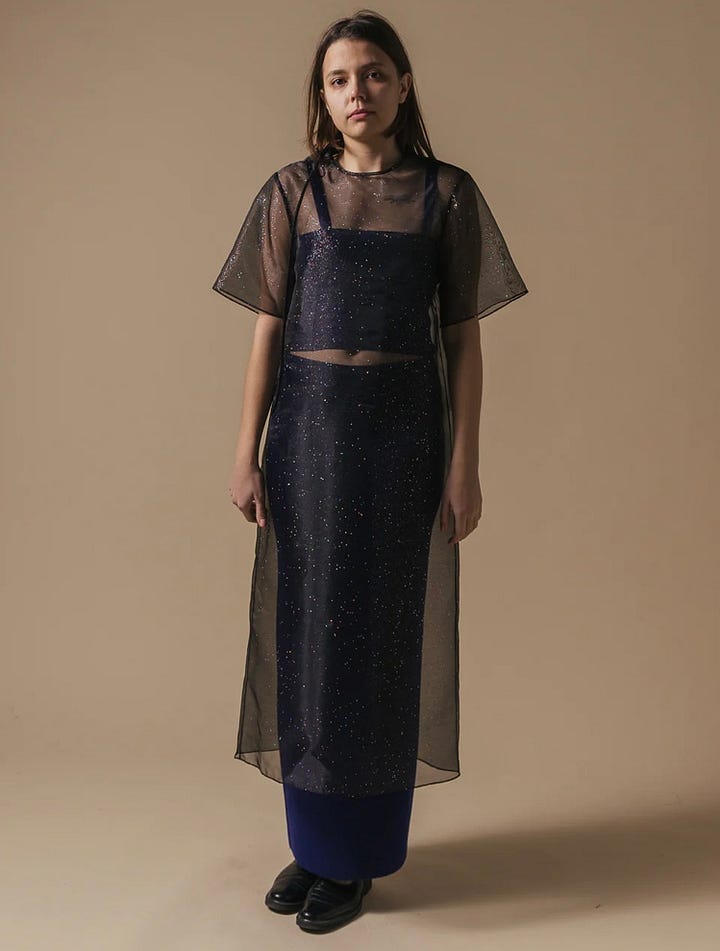
LM: Could you pick one AW24 item and take me through the various steps involved in its design and production?
FM: “Yes, sure. Let’s take the ‘Spark & Twinkle’ items.”
LM: Where was the fabric sourced?
FM: “Greece — dead-stock.”
LM: What inspired the design?
FM: “The material was absolutely beautiful but quite stiff and not easy to stitch even with thin yarn and needles. We decided to work the simplest of shapes as layering pieces. The material itself was complicated enough as it was see-through, sparkly and stiff. We used very delicate French seams all over to give the construction ‘bones’, contrasting with the sheerness of the fabric and couture rolling finishes.”
LM: Where’s it stocked?
FM: “All items were stocked at various Asian stockists worldwide — including Boon the Shop, French + Italian and United Arrows — and some of them still are available in a few sizes. On our own online store, we only have the ‘Fairy Dress’ in S left.”
LM: Looking ahead, what’s to come in 2025? What new themes are you’re exploring?
FM: “I don’t really work with a concept or theme, to be honest. I prefer to frame and focus through the fabrics that I instinctively put together. That said, SS25 is called ‘Alice’ — and we really look forward to getting it out into the world.”
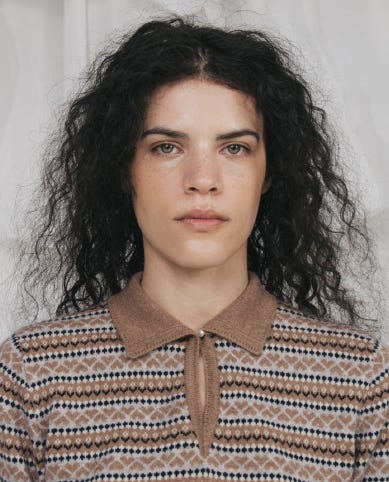

Eleph is available from over 40 stockists worldwide and through the brand’s own online store. All images courtesy of Eleph.





